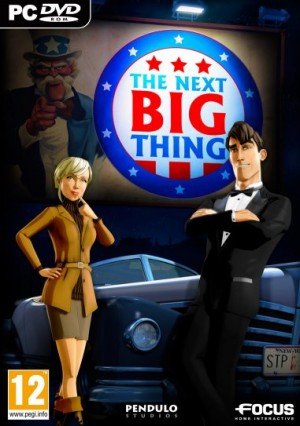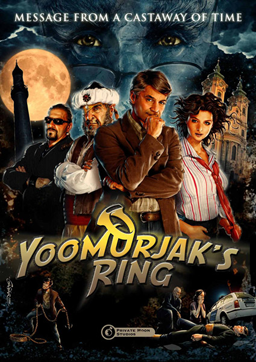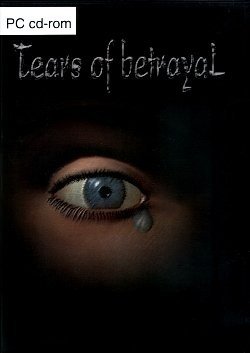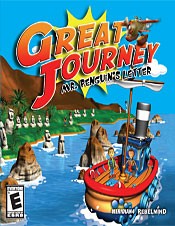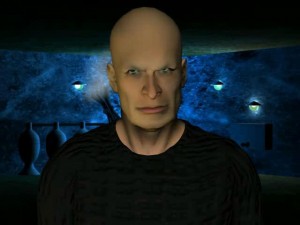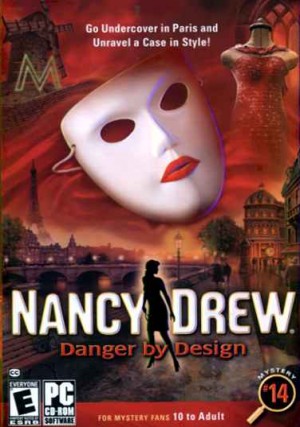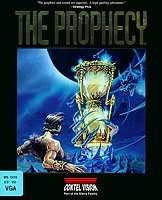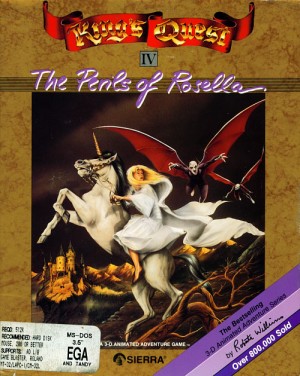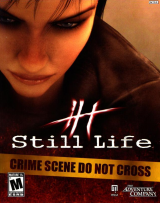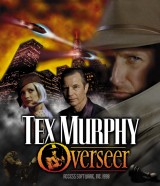Review for The Next BIG Thing page 2
In a strange underwater lab, feted sports journo Dan Murray anxiously watches a Frankenstein-like experiment while his buddy Dr. Fly – part man, part fly, all buzz – hovers noisily above him, ready to zap the monster to life... But wait, what's that, Mr. Narrator? False start, you say? Alright, let's try again: this time at the Horror Movie Awards in Hollywood, where the night is young, the stars are out and Dan's in attendance, ensconced in the best seat in the house – a swanky car in the parking lot. He isn't alone; with him are his trusty hip flask and his motormouth colleague from The Quill, celeb reporter/aspiring investigative journalist/eccentric blonde vixen, Liz Allaire. It’s a match made a little short of heaven if their rapidfire bickering is any indication ("Jerk!" she snaps; "Lunatic!" he retorts), but soon they spy Big Albert – a monstrous mash-up of a bodybuilder's body and a scientist's brain – sneaking into movie mogul William FitzRandolph's mansion through an open window. And thus, the game is afoot.
Pendulo Studios certainly isn’t a stranger to weirdness, as the Spanish developer has been honing its craft since the “runaway” success of their first major release a decade ago. Two sequels and over a million sales later, Pendulo decided to give Brian and Gina some much-deserved rest, and started brainstorming on the next big step for the genre. Ironically, they looked to the past for inspiration and found it in their own Hollywood Monsters. Rather than create a sequel or simply remake their never-localised 1997 adventure, Pendulo decided to rework the original concept into an all-new storyline instead. The end result is The Next BIG Thing... or is it? Let's find out!
The first thing that jumps out is the sheer American-ness of the production, from the stars-and-stripes logo to its setting in the heart of 1940s Hollywood to the lavish script that's an unabashed tribute to American pop culture. The second is Pendulo's trademark comic-style art of mildly exaggerated cartoons, displaying a vibrant, visually engaging world with a personality of its own. By all appearances, Tinseltown has never had it better, riding the crest of the horror movie business in which real monsters are the stars. But it's a world that thrives on make-believe after all, so it's no surprise that all's not really well underneath the glitz in LaLa Land. The winds of change are blowing in, with rumours of family movies, musicals and romcoms on the way. MKO Pictures, the big-daddy of horror movie studios, is spearheading this change towards greener pastures, and the myriad monsters – genuine and fake, alien and mutant, friendly and mean – are suitably distraught by the looming loss of their livelihoods.
With whispers of a monster rebellion buzzing around the grapevine, Liz is driven by her indefatigable fervor to bag a scoop in discovering what covert operation Big Albert is carrying out in FitzRandolph's office. This isn't an easy task, as it involves giving a despondent alien a flashy new future, scamming a weather-beaten robotic sentry, and most problematically, finding a way to motivate her apathetic cohort to cooperate. But that's just the start of an increasingly bizarre adventure. When Liz’s initial investigation collides with an unexpected twist of fate, it's up to a hungover Dan to make sense out of nothing at all. The plot soon thickens into a mish-mash of mind-blowing (sometimes literally) revelations, and as Dan chases the story's real villains with the help of his monster pals, an endeavour that includes getting creative with pain-inducing novelties and playing dress-up as a fictitious Pharaoh, Liz must fight her own demons in a couple of lengthy sequences spent inside her head.
In contrast to its wide-reaching storyline, the gameplay in The Next BIG Thing is fairly streamlined. There are three difficulty modes to choose from at the start of the game: easy has in-game hints and hotspot highlights, medium only the latter, and difficult offers neither. Most screens have no more than four or five (and often fewer) hotspots, including red herrings, and the desired look and use/talk actions can be cycled by right-clicking. Some yield items that are added to the inventory while others are usable with items you’ve collected. Objects are usually described with lengthy anecdotes, and inventory items sometimes reveal further details concealed within them. Clicking the hotspot highlight icon from the rollout menu at the top of the screen reveals all interactive areas, but like every good thing in life, this privilege – and the hints system if you're taking it easy – aren't unlimited: the control panel has gauges for both, which deplete as the features are used, though you’d have a tough time using them up completely. Conversations have multiple options, but it doesn't matter how you proceed. Usually all topics appear during the first chat with a character in a chapter, then sentences within topics are added based on subsequent events, making it necessary to rehash the points repeatedly in a unique, but nevertheless confounding, form of backtracking.
The game is separated into six distinct chapters defined by location and/or the active character. Each chapter has five or six interactive screens, and a similar number of “checkpoints” based on its key objective, explained briefly by the narrator. These checkpoints keep you on track in the absence of a journal or quest list, but given the game's simplistic goals and overall linearity, they’re more a fun feature than a real requirement. There are two types of puzzles: the crazy easy and the plain crazy, and the game relies on the wackiness of the puzzles to throw players off rather than volume of activity. But wackiness for its own sake can be (and in several cases here is) counterproductive. Outside-the-box thinking? Yes, please! But try-everything-with-everything-else-because-it's-nowhere-in-the-zipcode-of-the-box thinking? Fun occasionally, not so much when it reduces a significant portion of the game to playing hotspot mix-and-match. Even Dan admits apologetically after one such exercise, "I know it made no sense, but I really wanted to (solve the task that way)." as does Liz, before creating something called “foolishness” out of two ridiculously random items, exclaiming, "I don't know why, I have a feeling this will turn out to be nonsense..."
The puzzles are almost entirely inventory-based, sometimes combining collected items together before using them elsewhere. The 21 inventory slots are rarely even one-third full despite carrying useless things like Liz's ID and Dan's hat, along with items that have already served their purpose, which are cleared only when the chapter changes. The objects are suitably bizarre and include a soul extractor, a fake chupacabra claw and a tom-tom, though the usual suspects – rope, spray paint and voodoo doll – also play their parts. Objects sometimes appear unannounced when screens are revisited after certain events, so paying attention while retracing your steps is important. There are only a handful of standalone puzzles, several of which involve dialogue choices. None are excessively challenging, but one involving hieroglyph syntax deduction is delightfully tricky, while another featuring musical tunes is painfully so. The logic of most puzzles, including some inventory challenges, are explained after they are solved, perhaps for the benefit of those who succeeded by trial-and-error.
Like the Runaway series, The Next BIG Thing is led by a beautiful babe and a dashing dude – in this case frenemies Liz and Dan. Liz spent her childhood in a gilded household with numerous nannies and constant reminders from her mother to maintain decorum since she's an Allaire, and mentions several times with pride that her good manners are the result of her stint at a finishing school. She's smug about her slim frame and sense of sartorial elegance, and takes herself and her work very seriously. She's also totally neurotic, and her irrational fear of crocodiles, inability to count to four, and disturbing tendency to carry out lengthy conversations with herself merge with a loud clang that can keep your ears ringing for a while till you get used to her hyperactivity. But she's also compassionate and sincere, intelligent and helpful, and has a clear value system of right and wrong. Over the course of the game she conquers not only her own fears, but also your heart with her joie de vivre.
Dan is a worthy foil to Liz in the appearance and smugness departments – tall, square-jawed and handsome, he's also a fountain of vanity, and we never hear the end of his prowess as a ladies' man. He's also neurotic – about sports, as almost every remark he makes includes at least one related analogy. That is, when he's not betting half his salary on whatever new situation is worth gambling on. He's laid-back, practical and cynical, having seen too much of real life to be perturbed about it, and is generally disdainful of the 'struggles' of the privileged, particularly Liz. But though he's absolutely incapable of not rebutting her every comment, he's inexplicably drawn to her, much to his own chagrin, and hides this perceived weakness by getting on her case at every available opportunity. This game only hints at an imminent romance, buried deep in denial territory for now, though the epilogue suggests there are many more adventures together to come.
As for the supporting cast, it's a monster's ball. The peculiar premise allowed the developers to introduce a motley crew of mutants, aliens and robots, and while many are mentioned or seen in passing, several are integral to the story. Poignant backstories enrich the roles of man-mountain Poet of Pain and pet-monster Tobby the III. Big Albert looks and sounds like Schwarzenegger, though his borrowed Nobel Laureate brain gives him a larger vocabulary; Krom-Ha, a delectable Egyptian mummy posing as the High Priestess of magic, bears an uncanny resemblance to Liz Taylor in Cleopatra; and gaunt, black-clad, snooty actress Eva Morte is inspired by Morticia Addams. A chunky role is reserved for Dr. Fly, the winged crusader with a state-of-the-art yacht lab and spit full of acid. But the most intriguing supporting actor is the leathery-skinned FitzRandolph, the rags-to-riches tycoon who owns MKO Pictures. He's suave and erudite, with a multilayered personality that matches his custom suits and refined baritone. The silver ‘Golden Chicken’ goes to the Oracle of the Shadows for his priceless cameo behind a white linen curtain, while Liz's prodigious, punctuation-obsessed sister Anne-Marie gets the honourable mention, wrestling it with understated elegance from the clutches of the rudest Australian in Scotland, the headless Spencer McDundee.
In their signature style, Pendulo has painstakingly created a vibrant, exciting and slightly twisted comic world for these characters to cavort (or wallow, since most are poster children for prescription meds) in. The high resolution hand-drawn backgrounds, especially the Egyptian-themed magic theatre and a zeppelin, are as luxurious as the places they depict, rich with colour and flourishes. Day and night scenes are interesting to compare, as are locales that 'progress' when you return after a while, such as grafitti being wiped off a wall or a painting being completed. The inside of Liz's head is an even more surreal place, compartmentalised into rooms filled with bizarre combinations of people, possessions and events that have impacted her life. The characters, though cartoony, have life-like expressions and movements, and watching Liz sashay around and Dr. Fly hover about never gets tiresome. The best animation sequences include the robot Jimmy Love's attempts at opening a door, Dan 'Amenofis the Third' Murray's grand entry into the magic theatre, and Liz accidentally encountering Dan in a Tarzan costume while Tobby swings by. There are also many cutscenes, which usually appear during checkpoints and often feature extreme and melodramatic close-ups. Standout cinematic clips include Liz making an Indiana Jones-esque escape on a motorcycle with a sidecar, and a fabulous home-shopping infomercial featuring both leads.
The background score, eclectic and moody, ranges from both cheerful and morose jazz to lilting Spanish guitars, thumping Egyptian percussions, exotic African beats and elegant piano compositions according to the scenes. Sound effects, like characters walking over varied terrain and background noise like the ocean's rumble, are effective without being overdone. The entire cast of characters is voiced by an expert team, but by far the most memorable performance is Liz's vivacious society-girl talk, which literally covers the entire gamut of emotions from happy to surprised to angry to distraught to petulant and then happy again, all within a span of seconds. Also excellent are FitzRandolph's mature, sometimes indulgent speeches, Anne-Marie's oh-so-gentle putdowns, and Dr. Fly's lisp. The raspy-throated Dan is disappointing, though; he sounds older than he looks, and barring a few moments where his snarky irreverence shines through, he comes across as too bored to justify his charming persona. Pitted across firebrand Liz, it's a TKO.
Perhaps the best part of The Next BIG Thing is its firmly tongue-in-cheek script. It's both deferential and merciless in its parodies of pop culture, celebrities and Americana, treading the razor's edge with remarkable skill and style. The dialogues and descriptions are crisp and clever, littered with allusions to famous movies, books, songs, art, sports, video games and political events, and there's bound to be something in there for every player. Not everything is as in-your-face as the Immaterial Man either; woebegone robot gardener Phil is modeled on Marvin, the depressed robot from Hitchhiker's Guide to the Galaxy, while faux-alien Edgar often hails Dan with the familiar greeting of Looney Tunes' Marvin the Martian. An additional source of humour are item names, labelled whatever the playable character currently thinks about them – which is especially literal in Liz's case. As for the characters, no pretence is overlooked, no remark unpunished. The chatterbox leads (Liz in particular) expectedly have the best (and most) lines, but everyone gets their moment under the Californian sun. The monsters playing a word guessing game is funny every time, FitzRandolph has several genuinely laugh-out-loud comments, and it's freaky how many names starting with 'E' Dan incorrectly addresses Edgar with. It's equally freaky how often 'ayo' and 'whatta guy' can be said without making you want to shove pencils into your ears.
A gem tucked away in the Control Panel is the Statistics feature, which starts with stats about the game – hours played and calories burnt (zero, by the way) – then succumbs to infectious, hilarious insanity. Curious how many four leaf clovers were found by government employees with a 33% reduction in working hours? You’ll find the answer here! Or, if you fancy yourself as a brainiac, answer this: what's the absolute percent of increase in the velocity of the expansion of the universe caused by dark energy? Yes, it is 3.1416% (according to their calculations) – here, have some pi! But while this is easily among the most entertaining extras ever and earns its developers due credit, a little extra effort in the main game might have helped turn out a flawless product. As it stands, there are quite a few mistakes – in one location, an exit is labeled as a 'jar', while another time a 5000-year old staff is referred to as the one thing it most definitely is not. On quite a few occasions, dialogues are mismatched, including pre-completion commentary persisting even after tasks are finished. One visual glitch involves a snail-shaped coat rack becoming invisible on revisits to the location, though it can still be interacted with.
These few rough edges aside, overall The Next BIG Thing is a lovingly crafted production – its sights and sounds are exquisite, the oddball characters are fascinating, and the whimsical script is epic – the nutty conversations are certain to amuse even the most dour cynic. But beneath the beautiful wrapping rests a thin storybook, too few toys to play with, puzzles that are either too obvious or not-obvious-enough, and Barbie-and-Ken dolls who don't quite click with each other yet. The game is quite limited and linear in scope (taking under ten hours to complete), and while it kicks off with great promise, the plot starts to lurch forward in barely-connected chunks that befuddle rather than intrigue, eventually ending with almost childish simplicity. It also focuses almost exclusively on developing Liz as a character, and consequently leaves Dan woefully shortchanged. Not only that, but we rarely see Liz and Dan together; nor do they ever work in tandem, which is disappointing. So in the end, we return to the crucial question: have we encountered The Next BIG Thing? Not entirely, though it's a sleek and witty debut that's definitely worth a fly-by for fans of offbeat comic adventures, with plenty of reason for optimism about the possibility of sequels to come.


